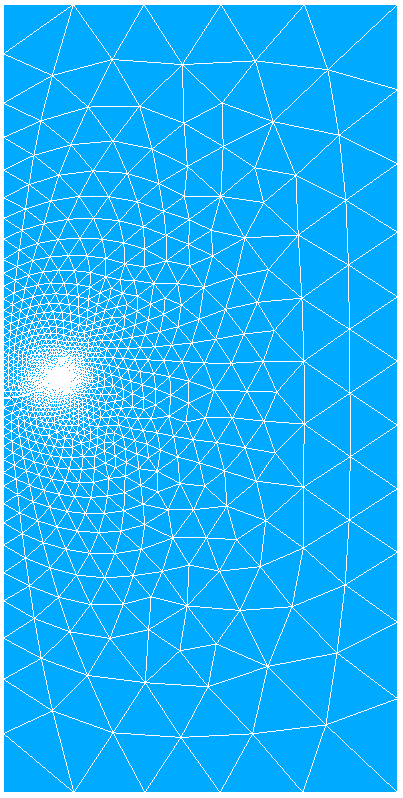3. Modeling A: Modeling FEM 2d-AXI#
3.1. Characteristics of modeling#
In this modeling, the crack is meshed (case FEM) and the structure is modeled using 2D-axisymmetry.

Figure 3.1-1:2D-axi mesh (FEM)
3.2. Characteristics of the mesh#
Number of knots: 5211
Number of meshes and type: 2550 TRIA6
The characteristic length of an element near the crack bottom is h = 0.025m.
The middle nodes of the edges of the elements touching the bottom of the crack are moved to a quarter of these edges (Barsoum elements).
3.3. Boundary conditions and loads#
A surface tensile force is applied to the upper, lower and right sides;
The movements following \(\mathit{Ox}\) of the nodes of the axis of rotation are blocked, as recommended for axisymmetric models;
The rigid mode of movement along the \(\mathit{Oy}\) axis is blocked by blocking a node along this axis.
3.4. Tested sizes and results#
The values of \({K}_{I}\) and \({K}_{\mathit{II}}\) at the bottom of the crack obtained with the operators CALC_G and POST_K1_K2_K3 are tested. These values are compared to the analytical solution.
The theta field integration crowns for command CALC_G are:
\({R}_{\text{inf}}\mathrm{=}2h\) and \({R}_{\text{sup}}\mathrm{=}5h\).
The ABS_CURV_MAXI parameter for the POST_K1_K2_K3 operator is chosen by default.
3.4.1. Values from CALC_G#
The values are in \(\mathit{Pa}\mathrm{.}\sqrt{m}\).
Identification |
Reference Type |
Reference Value |
% Tolerance |
\({K}_{I}\) |
“ANALYTIQUE” |
1.177 106 |
|
\({K}_{\mathit{II}}\) |
“ANALYTIQUE” |
0.3153 106 |
|
3.4.2. Values from POST_K1_K2_K3#
The values are in \(\mathit{Pa}\mathrm{.}\sqrt{m}\).
Identification |
Reference Type |
Reference Value |
% Tolerance |
\({K}_{I}\) |
“ANALYTIQUE” |
1.177 106 |
|
\({K}_{\mathit{II}}\) |
“ANALYTIQUE” |
0.3153 106 |
|